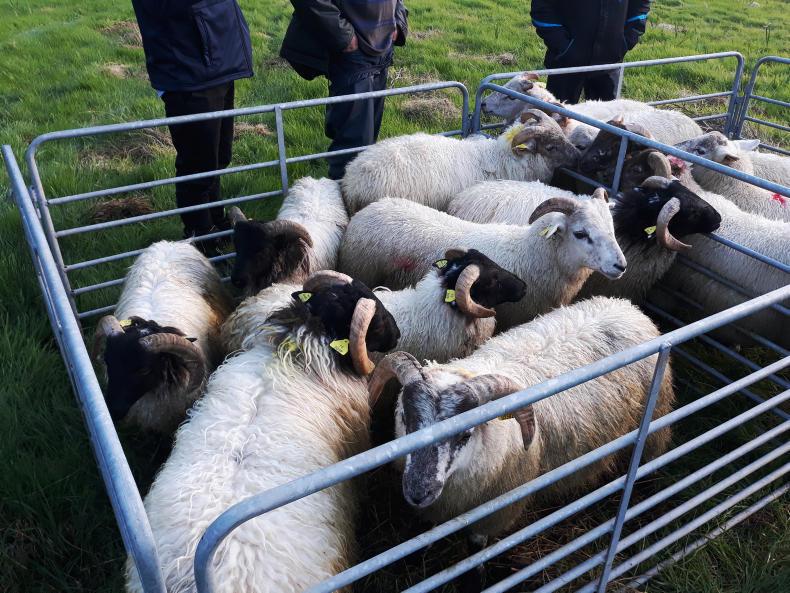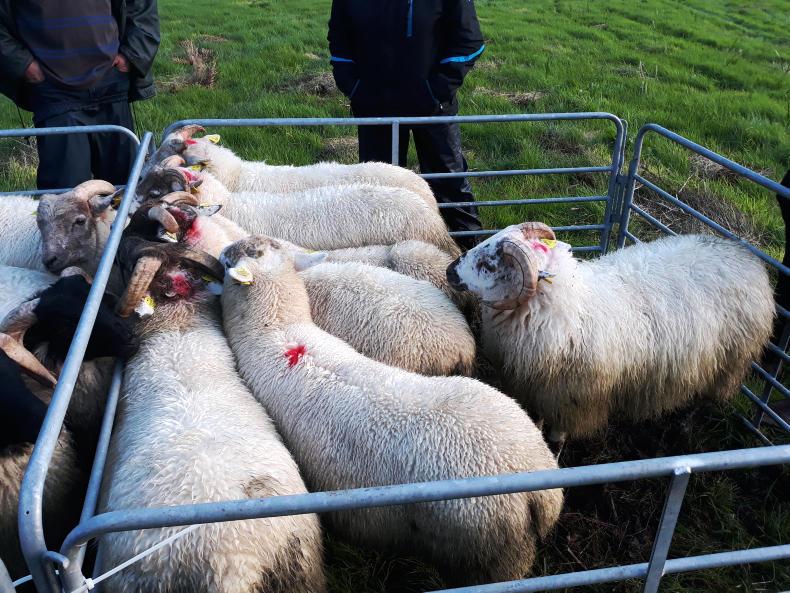Determining the optimum plan for finishing hill lambs should be an immediate task on farms, if not already complete.
This was part of advice delivered by Teagasc sheep specialist Frank Campion at Thursday evening’s Teagasc BETTER Farm programme hill farm walk on the farm of Francis and Bernie Gonely in Tormore, Glencar, Sligo.
Priority
Frank told farmers that the priority on farms should now be turning to ensuring ewes have a sufficient supply of grass for breeding.
Central to this is allocating what grass is needed for ewes and determining the best finishing plan for lambs with what grass is left.
Farmers were advised to weigh their lambs and group lambs on the basis of their weight.
Introducing meals now or transferring lambs on to an intensive finishing diet will only result in lambs finishing at very light carcase weights
This information will feed directly into what options work best for the farm.
Frank said that small framed light lambs weighing less than 30kg liveweight are a longer-term prospect and ideally need to be grazed until the end of the year or early 2020 before finishing.

Finishing plans vary depending on the weight of lambs.
This is to allow lambs to develop a sufficient frame to carry weight, as introducing meals now or transferring lambs on to an intensive finishing diet will only result in lambs finishing at very light carcase weights or requiring uneconomical levels of meal feeding to reach French market weights.
Where this is not an option, then the best outlet for these lambs may be the store trade.
Lambs weighing 30kg to 35kg will also benefit from a period of grass, while lambs weighing in excess of 35kg can feasibly be introduced to concentrates.
Frank advised farmers to take advantage of the Teagasc store lamb budget calculator to ascertain if selling live or bringing through to finish is the most suitable option for the farm.
The online calculator is easy to use, but where farmers do not have access to it, their Teagasc adviser will be in a position to help.
Table 1 details the weight of lambs at weaning on 1 August, while Table 2 details the range in weights.
Francis Gonely said, in recent years, all lambs were kept on the farm and transferred at a stage to his lowland farm before finishing indoors.
Temporary grazing was rented for ewes to facilitate this.
Budget
This year, a budget was completed on finishing lambs, taking account of the cost of rented grazing, while also assessing the store trade.
He said the store lamb trade was too good to pass up for light lambs and a decision was made to sell all the light lambs under 25kg.
These were generally the lambs that normally end up consuming the most grass and competing with ewes.

Concentrates will be introduced to lambs weighing in excess of 40kg liveweight to improve fat cover and slaughter performance.
Lambs weighing in the region of 25kg to 35kg will be retained on grass only in the short term, while there is a batch of lambs weighing upwards of 40kg which are performing OK but lacking flesh.
Concentrate feeding will be introduced to these lambs now and, weather-dependent, lambs will be housed for a short finishing period.
Performance on grass
Frank Campion expanded on this point and told farmers performance on grass should not be overestimated.
At present, the aim is for lambs to gain in the region of 1kg per week.
However, given the level of rainfall since the start of August and the low dry matter of grass, performance is likely to be running at 50% of these levels.
He concluded by advising farmers to reassess performance on a regular basis and tweak plans where necessary to keep finishing plans on track.
Read more
Hill sheep breeding strategies for optimum performance
Store lambs – what are the finishing options for 2018?
Determining the optimum plan for finishing hill lambs should be an immediate task on farms, if not already complete.
This was part of advice delivered by Teagasc sheep specialist Frank Campion at Thursday evening’s Teagasc BETTER Farm programme hill farm walk on the farm of Francis and Bernie Gonely in Tormore, Glencar, Sligo.
Priority
Frank told farmers that the priority on farms should now be turning to ensuring ewes have a sufficient supply of grass for breeding.
Central to this is allocating what grass is needed for ewes and determining the best finishing plan for lambs with what grass is left.
Farmers were advised to weigh their lambs and group lambs on the basis of their weight.
Introducing meals now or transferring lambs on to an intensive finishing diet will only result in lambs finishing at very light carcase weights
This information will feed directly into what options work best for the farm.
Frank said that small framed light lambs weighing less than 30kg liveweight are a longer-term prospect and ideally need to be grazed until the end of the year or early 2020 before finishing.

Finishing plans vary depending on the weight of lambs.
This is to allow lambs to develop a sufficient frame to carry weight, as introducing meals now or transferring lambs on to an intensive finishing diet will only result in lambs finishing at very light carcase weights or requiring uneconomical levels of meal feeding to reach French market weights.
Where this is not an option, then the best outlet for these lambs may be the store trade.
Lambs weighing 30kg to 35kg will also benefit from a period of grass, while lambs weighing in excess of 35kg can feasibly be introduced to concentrates.
Frank advised farmers to take advantage of the Teagasc store lamb budget calculator to ascertain if selling live or bringing through to finish is the most suitable option for the farm.
The online calculator is easy to use, but where farmers do not have access to it, their Teagasc adviser will be in a position to help.
Table 1 details the weight of lambs at weaning on 1 August, while Table 2 details the range in weights.
Francis Gonely said, in recent years, all lambs were kept on the farm and transferred at a stage to his lowland farm before finishing indoors.
Temporary grazing was rented for ewes to facilitate this.
Budget
This year, a budget was completed on finishing lambs, taking account of the cost of rented grazing, while also assessing the store trade.
He said the store lamb trade was too good to pass up for light lambs and a decision was made to sell all the light lambs under 25kg.
These were generally the lambs that normally end up consuming the most grass and competing with ewes.

Concentrates will be introduced to lambs weighing in excess of 40kg liveweight to improve fat cover and slaughter performance.
Lambs weighing in the region of 25kg to 35kg will be retained on grass only in the short term, while there is a batch of lambs weighing upwards of 40kg which are performing OK but lacking flesh.
Concentrate feeding will be introduced to these lambs now and, weather-dependent, lambs will be housed for a short finishing period.
Performance on grass
Frank Campion expanded on this point and told farmers performance on grass should not be overestimated.
At present, the aim is for lambs to gain in the region of 1kg per week.
However, given the level of rainfall since the start of August and the low dry matter of grass, performance is likely to be running at 50% of these levels.
He concluded by advising farmers to reassess performance on a regular basis and tweak plans where necessary to keep finishing plans on track.
Read more
Hill sheep breeding strategies for optimum performance
Store lambs – what are the finishing options for 2018?








 This is a subscriber-only article
This is a subscriber-only article









SHARING OPTIONS: